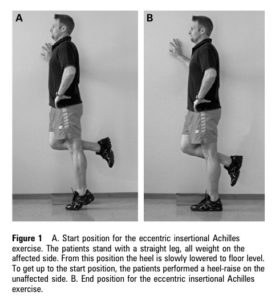 Dealing with an injury and not being able to run can be very frustrating. What can be even more frustrating is being misdiagnosed and prescribed a treatment that only makes the condition worse.
Dealing with an injury and not being able to run can be very frustrating. What can be even more frustrating is being misdiagnosed and prescribed a treatment that only makes the condition worse.
I was diagnosed with Achilles Tendonitis even though on examination and assessment by medical professionals, my mid-portion Achilles was not tender or painful on palpation. My pain is at the insertion site of the bone and Achilles tendon (back of heel), which leads me to believe that my injury is Insertional Achilles Tendinopathy (IAT). I also have a bony prominence (Bone Spur, Haglund’s deformity), which was confirmed on x-ray at one of the many doctor visits. Bone spurs can be associated with IAT, but not always.
I was prescribed a treatment that consisted of bilateral heel drops with full ankle dorsiflexion (dropping the heel below the stair) and calf stretches which work great for Achilles Tendonitis, but do NOT work very well for IAT. My own personal experience was proof enough for me that these exercises only make the condition worse.
Instead, this type of injury responds better to heel raises without ankle dorsiflexion. In a study of 27 patients with chronic IAT, almost 70% were able to return to their previous activities after 12 weeks of this type of exercise.
The treatment consists of heel drops on a flat surface done two times a day: 3 sets of 15 repetitions. The exercise starts out by raising the heel off the ground on the non-injured leg then shifting the body weight to the injured leg and while in the heel-raised position, lower the injured foot slowly to the floor. Once these exercises can be done without pain, weight can be added gradually. I have bilateral IAT, so I use a box and perform a leg press to get to the up position which works really well.
I have been doing these exercises for a few weeks, but have not been very motivated into adhering to the twice a day or even every day regimen. Since other treatments have failed, I wasn’t really that optimistic about this one either despite the outcomes in the study. I also have been out walking but not consistently. Things have changed, though, since I have been accepted into the NYC Marathon! My excitement and motivation (and attitude) has skyrocketed! I am doing these exercises twice a day plus walking for 30 min a day at least 5 times a week. I have also added foam rolling because I tend to have very tight calf muscles, and the recommendation for IAT is to not stretch the calf muscles. Also, being that compression can be problematic when the foot is in dorsiflexion, I am trying to avoid the following as recommended:
Walking or running uphill
Tight shoes that cause direct tendon compression
Flat or barefoot running shoes
Use of NSAIDS (may interfere with tendon-bone healing)
Resting if symptoms worsen
In addition, I have customized shoe inserts and being that I am a pronator, I wear a motion control shoe. The stiffness of the heel in these types of shoes could potentially aggravate my Achilles problem. I will be monitoring this very closely and will make adjustments as necessary. Also, I am sleeping in the night splint boot (left foot only). I read where it helped one runner after months of unsuccessful treatments.
Currently I am waking up with no pain. My left foot gets a little stiff at times throughout the day but once I am walking around, it is better. I only have 33 weeks before the marathon so I do not have time to waste. As mentioned, I have started walking every day and today I will test my foot with 30 seconds of running out of every 5 minutes of walking after a good warm-up of course.
Wish me luck!
If anyone has any information they would like to share about this type of injury; it will be greatly appreciated.
I am learning as I go and trying to figure out what works for me. As always, this information in no way should be substituted for medical or professional advice.

Leave a Reply